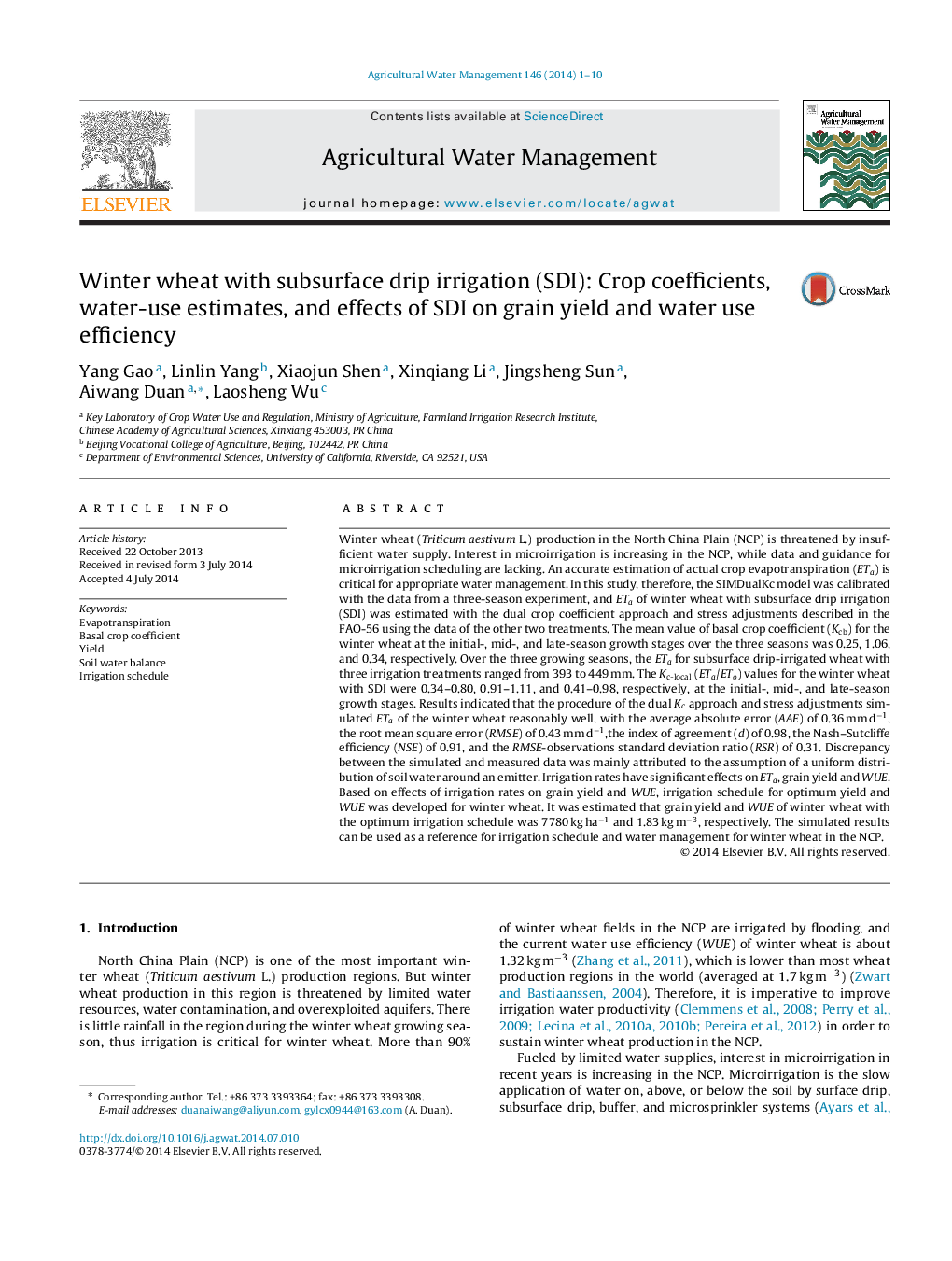| کد مقاله | کد نشریه | سال انتشار | مقاله انگلیسی | نسخه تمام متن |
|---|---|---|---|---|
| 6363929 | 1622933 | 2014 | 10 صفحه PDF | دانلود رایگان |
عنوان انگلیسی مقاله ISI
Winter wheat with subsurface drip irrigation (SDI): Crop coefficients, water-use estimates, and effects of SDI on grain yield and water use efficiency
دانلود مقاله + سفارش ترجمه
دانلود مقاله ISI انگلیسی
رایگان برای ایرانیان
کلمات کلیدی
موضوعات مرتبط
علوم زیستی و بیوفناوری
علوم کشاورزی و بیولوژیک
علوم زراعت و اصلاح نباتات
پیش نمایش صفحه اول مقاله

چکیده انگلیسی
Winter wheat (Triticum aestivum L.) production in the North China Plain (NCP) is threatened by insufficient water supply. Interest in microirrigation is increasing in the NCP, while data and guidance for microirrigation scheduling are lacking. An accurate estimation of actual crop evapotranspiration (ETa) is critical for appropriate water management. In this study, therefore, the SIMDualKc model was calibrated with the data from a three-season experiment, and ETa of winter wheat with subsurface drip irrigation (SDI) was estimated with the dual crop coefficient approach and stress adjustments described in the FAO-56 using the data of the other two treatments. The mean value of basal crop coefficient (Kcb) for the winter wheat at the initial-, mid-, and late-season growth stages over the three seasons was 0.25, 1.06, and 0.34, respectively. Over the three growing seasons, the ETa for subsurface drip-irrigated wheat with three irrigation treatments ranged from 393 to 449 mm. The Kc-local (ETa/ETo) values for the winter wheat with SDI were 0.34-0.80, 0.91-1.11, and 0.41-0.98, respectively, at the initial-, mid-, and late-season growth stages. Results indicated that the procedure of the dual Kc approach and stress adjustments simulated ETa of the winter wheat reasonably well, with the average absolute error (AAE) of 0.36 mm dâ1, the root mean square error (RMSE) of 0.43 mm dâ1,the index of agreement (d) of 0.98, the Nash-Sutcliffe efficiency (NSE) of 0.91, and the RMSE-observations standard deviation ratio (RSR) of 0.31. Discrepancy between the simulated and measured data was mainly attributed to the assumption of a uniform distribution of soil water around an emitter. Irrigation rates have significant effects on ETa, grain yield and WUE. Based on effects of irrigation rates on grain yield and WUE, irrigation schedule for optimum yield and WUE was developed for winter wheat. It was estimated that grain yield and WUE of winter wheat with the optimum irrigation schedule was 7780 kg haâ1 and 1.83 kg mâ3, respectively. The simulated results can be used as a reference for irrigation schedule and water management for winter wheat in the NCP.
ناشر
Database: Elsevier - ScienceDirect (ساینس دایرکت)
Journal: Agricultural Water Management - Volume 146, December 2014, Pages 1-10
Journal: Agricultural Water Management - Volume 146, December 2014, Pages 1-10
نویسندگان
Yang Gao, Linlin Yang, Xiaojun Shen, Xinqiang Li, Jingsheng Sun, Aiwang Duan, Laosheng Wu,